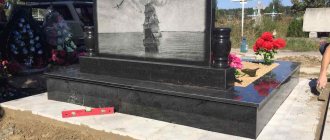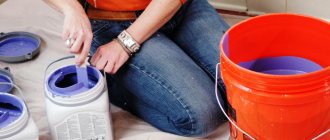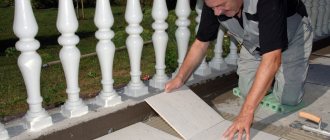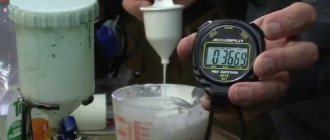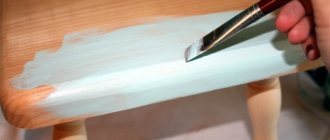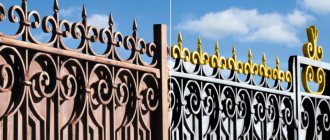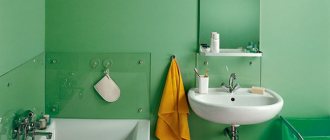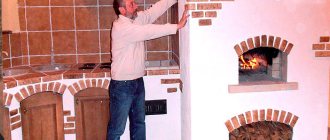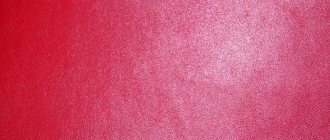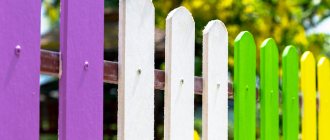Granite and marble are durable materials, but when used for monuments, time has a negative impact on them. After several years, you may find that the monument has begun to look aesthetically unpleasant, and the inscriptions have faded or been completely erased. It is not necessary to completely replace the product; restoration work is allowed. In this case, you can cope on your own, without turning to professionals. It is important to choose the right paint for monuments. The process and types of coatings will be discussed in detail below.
Monument care
To avoid having to frequently resort to painting the monument, proper care is required. Experts recommend adhering to the following principles for caring for granite and marble products:
- Trees and bushes should not grow near the product; due to their root system, it can damage the material. You shouldn’t plant a lot of flowers nearby either, they attract moisture, which negatively affects the stone;
- No aggressive chemical elements are used to wash the surface of the monument; any kitchen detergents are also not suitable. Due to their influence, the surface is destroyed, the cohesion of the factions becomes weaker;
- Do not use hot water or fire nearby, these elements lead to the formation of stains on the surface.
If expensive marble was used, then for safety in severe frosts, it is advisable to cover the monument with something. Film coatings or moisture-resistant fabrics can be selected. If cracks or chips have formed, they are covered with polish or other suitable means to protect the stone. The product will prevent the defect from enlarging.
No aggressive chemical elements are used to wash the surface of the monument; any kitchen detergents are also not suitable.
DIY painting method
There are several ways to add color to gypsum stone. The most commonly used method is hand painting with a brush. Each tile is painted with a base color, and then several pieces are highlighted with a darker shade. When applying paint, care must be taken to ensure that no smudges form and that no unpainted fragments remain. This method is labor-intensive and time-consuming, so it is used for painting a small amount of tiles and eliminating defects.
The use of electric and pneumatic tools makes the job easier. Painting gypsum products with a spray gun is popular among professional craftsmen. To do this, the tiles are laid on a horizontal surface measuring 1x1 m and the base layer is applied with a spray. The technology for applying shades is simple: after the tiles have dried, a layer of paint of a darker color is applied to individual areas using an airbrush or spray gun with a fine nozzle.
Some experts believe that it is best to paint tiles laid on the wall. This makes it possible to place darker pebbles over the entire treated surface. Paint applied to plaster dries quickly, which helps to immediately identify and eliminate defects. After this, the tiles are varnished. With this surface treatment, the care of the product is simplified, since you can wipe the gypsum stone with a damp cloth without fear of smearing the paint.
Mixing pigments to create color
Painting of plaster can be carried out both during the manufacture of the product and after. In the first case, the pigment is added to the mixture or directly into the mold, and in the second - into the paint. It is difficult to select the same color of gypsum mixture in large volumes. Therefore, this method is used for the individual production of small quantities of tiles.
It is easier to prepare paint using dry pigment or liquid color. It is not recommended to mix several colors to obtain the desired shade, because when mixed with paint, colored stains may appear. With a large volume of work, it is simply impossible to obtain the same color.
If a dry dye is used, it must first be dissolved in water and then added to the paint. To prepare the background and shading mixtures, different containers are used. If the tiles are painted to look like brick, the shading color is most often made lighter than the base color. Before applying the next layer, each time it is checked whether the previous one has dried. It must be remembered that after the product dries, its color becomes lighter.
Restoring the inscription on the monument
Monument paint, gold or another color, may be needed to cover faded letters. Paint is an easy option to update signatures; the painting process is simple, so you can restore the clarity of the color yourself. And this will significantly save your budget, because professional services can be expensive. For work, you should select the paint in advance, prepare the required tools, and only then you can proceed to painting. Below we will describe in detail how to paint the monument and how to do it.
Monument paint, gold or another color, may be needed to cover faded letters.
Paint selection
Stone paint for monuments must be selected correctly; not all products will be a good option. Some may move away from the surface too quickly after painting or may not adhere to the stone base. Sometimes the product peels off quickly, although the coloring occurred without problems, and the result leads to worse external properties than it was before applying the paint. Eliminating unnecessary paint is difficult; it is necessary not to scratch the material during the process.
How to paint a marble monument or another? Specialized compositions are selected, especially when it comes to letters. Products labeled “paint for marble for exterior use” based on acrylic have proven themselves; they are chosen not only for inscriptions, but also for border elements and other structures located in the cemetery. At the same time, they are also suitable as an option for painting a concrete monument.
You should not choose them if the installation was carried out using plaster without cement in the composition.
Marble paint for monuments has the following advantages:
- Durability;
- High degree of UV resistance;
- High air permeability.
You can find products in various colors on the market. The standard colors are gold, silver, black or white. You can choose between a matte or glossy effect; drying of acrylic paints takes a couple of hours. They do not emit a strong odor and are applied with a brush. If the consistency is too thick, dilute the paint with water; the shelf life of the layer is 5-10 years. You can also upgrade ordinary paint and varnish material; detailed recipes will be given later.
Specialized compositions are selected, especially when it comes to letters.
Necessary materials
The success of the result also depends on properly prepared tools and materials. To work you will need:
- Plastic spatula;
- Cleaner in paste form;
- Soft rags;
- Thinner – alcohol, with acetone;
- Gold paint on stone or other color;
- Brush;
- A means for fixing the last layer.
The success of the result also depends on properly prepared tools and materials.
Operating procedure
Begin by cleaning the surface, using a soft, damp cloth to wipe away dust and dirt. You should not leave any plaque elements in place; to remove complex contaminants, use a special paste containing phosphoric acid. The area with dirt is treated with the product, after fifteen minutes, the pasty layer is removed with a spatula.
Degreasing is carried out, only the dried surface is painted, then the following actions are performed:
- The brush is soaked in the selected material; it is important to remove the excess.
- Paint over the existing inscription, if desired, draw a new image.
- Wait until the layer dries completely.
- A fixing agent is applied; it will be more convenient to work in an aerosol form.
The inscription must be applied quickly; the paint may still dry on the painting tool.
It is necessary to apply the inscription at a fast pace.
It is possible to transform the structure of the inscription on a monument without the use of paints; polishing with zinc powder will help make the letters clearer. The method is used if you need to refresh the color, if the letters have already disappeared, then you cannot do without paint.
They work like this: the powder collected on a napkin is rubbed onto the required areas. The substance will help you easily obtain rich, bright elements. However, such a conversion should be carried out periodically, usually every couple of months.
Polishing with zinc powder will help make letters clearer.
Painting in bulk with an airbrush
I painted the tiles in the mass with yellow pigment, then diluted a caramel-colored color paste with water and applied it to some areas of the tiles with an airbrush.
Kohler paste
It turned out very beautiful.
Coloring in the mass with the application of color paste
Minus: you need an airbrush, which costs about 3 thousand + compressor (from 5 thousand and above).
Plus: a fairly quick method of coloring, it’s the best in production.
Restoration of letters
Restoration work with letters does not require much time, they do not take up a lot of space, accuracy is more important here in order to repeat the previous beautiful font. The clarity of recordings deteriorates faster, rain, snow and other natural factors affect the moment.
You can use painting or rubbing with special zinc powder for restoration. The first method will last longer, but requires more time. And the second will be a short-term method, but it is carried out easily and quickly.
You can use painting or rubbing with special zinc powder for restoration.
Painting portraits and inscriptions on a granite monument
Granite surfaces are easier to work with than marble surfaces. Granite is less demanding to care for, the material’s reaction to the use of thinners is calmer, and the likelihood of lightened defects appearing is lower. It is recommended to choose granite paint for monuments for the main area of the product in spray cans. The letters are painted using an old office using a thin brush.
There is another option, which is most often used by professionals. The method consists of applying a special acid in the required areas, it acts on the granite, and the necessary beautiful marks are obtained. But the technique is not suitable for independent implementation; it requires special skills and abilities.
Granite is less demanding to care for, and the material’s reaction to the use of thinners is calmer.
What glue is used when working with gypsum-based decorative stone?
Glue for installing decorative gypsum stone on walls Source stroy-podskazka.ru
Gypsum stone for decorative wall decoration is a very light material. It is installed using the following compounds:
- Putty with an admixture of gypsum.
- Tile adhesive with a mixture of gypsum.
- Acrylic putty.
- Special PVA.
- Gypsum mastic.
- Sealants for installation.
- Glue of the “Liquid Nails” or “Velcro” type.
You should choose a suitable glue based on its ease of use, availability in suitable packaging and your own financial capabilities.
Inscriptions on marble
If the letters have already peeled off almost completely or completely, then a more complex process of surface restoration will be required. The first step is to remove the old paint; fine-grained sandpaper can be used to work through all areas where elements of the paint layer remain. If you can’t remove the flaws with sandpaper, you can try a thin chisel, a utility knife, or a hammer. But all these tools are used carefully, otherwise the marble itself can be damaged.
The easiest way to remove the old layer is with a sander.
When the surface is clean, degreaser is applied and paint is applied using the standard method. If the monument is expensive, then it is better not to save money and entrust the work to professionals; installing a new one, if the monument is damaged, will cost much more.
If the monument is expensive, then it is better not to save money and entrust the work to professionals.
KM recipes from the people
As mentioned earlier, it is possible to change the characteristics of coloring agents using conventional components. This is an economical option for painting a marble monument. Add a little borax solution and drops of nitric acid to acrylic paint. As a result, you get white paint; you can use color to get a different shade.
Add a little borax solution and drops of nitric acid to acrylic paint.
Decoration options
Gypsum stone provides ample opportunities for decoration. By painting with this material, it is easy to imitate white or red brickwork and any types of natural stone, from the simplest to the more expensive and luxurious, such as marble. With the help of small tricks and tricks you can even create the effect of antiquity, and no one will say that this finish is only a matter of days or months old.
Imitation of red brick from gypsum decorative stone Source sense-life.com
Artificial gypsum stone in the interior of a bathroom Source rehouz.info
When choosing how to paint a decorative gypsum stone, remember that color affects visual perception. Light shades and small patterns will visually make the room larger and more spacious. Dark colors, on the contrary, seem to compress the space. Therefore, in small rooms, especially if there is little natural light and dim artificial lighting, dark coloring of gypsum stone should only be used spot-on.
Tips for caring for a monument
A marble monument is a product that requires special attention in terms of care. After all, the stone is whimsical, but timely maintenance can help reduce the frequency of restoration. It is required to clean the surface once every six months for prevention using the methods described below:
- Heavy stains are removed with special substances and a soft cloth is used to wipe them;
- After drying, impregnation is applied to the marble material; it acts as protection, making the surface dirt-repellent;
- Next, a moisture-protective agent is used, applied in several layers.
Manufacturers understand the specifics of natural stone, so they create products that are most suitable for it; it is better to purchase them.
A marble monument is a product that requires special attention in terms of care.
You can restore a monument in a cemetery with your own hands; the degree of the problem is taken into account, and based on this, a processing method and remedy are chosen. There are special paints on the market that will not be difficult to update the inscriptions with. But with expensive materials it is better if they work with specialists who guarantee the safety of the material.
Buy or make it yourself?
Manufacturers have developed many types of finishing materials. Gypsum bricks for interior decoration are presented in various modifications in catalogs:
- The glossy varnished version is fashionable.
- The matte muted look, which is treated with a protective compound, is interesting.
- Models with a flat surface, embossed or curved are equally in demand.
There are gypsum blocks on sale that replicate hewn stone segments or irregularly shaped minerals, but the easiest to use is an imitation of brickwork.
The entire spectrum of beige colors, shades of gray, brown, and sand are in demand. Many consumers prefer the color of natural brick or simple white. A colorless surface can be painted with selected paint. To the touch, decorative gypsum material can be smooth, structured or rough.
If desired, a home craftsman can make a lightweight and stable stylized brick himself. This process is quite labor-intensive and requires strict adherence to the recipe and the availability of suitable containers for filling the composition. Experts advise using commercially available silicone molds.
The main ingredients for creating such a finishing material will be: gypsum itself and PVA construction adhesive. If desired, a decorative color or pigment can be used; a white version can be formed. To prepare a solution of the required consistency, water is added when mixing the components.
For 1 kg of dry powder you will need approximately 0.5 liters of liquid and about 50 g of PVA. You can add polypropylene fiber for reinforcement: you will need 1-2 g of it per kilogram of gypsum base.
The required amount of dry matter is gradually poured into the container, water and glue are also added gradually. The resulting “dough” is stirred until smooth, resulting in a composition reminiscent of 25% sour cream.
To stimulate the setting process, some craftsmen add citric acid to the solution: about 0.5 g per standard bucket. The coloring pigment is first diluted in water and added to the total mass at the end of the preparation process.
The molds can be greased with petroleum jelly or treated with soapy water. The mixture is poured in one layer and after half an hour the decorative “masterpiece” becomes solid. It is recommended to coat finished products with an acrylic primer.
